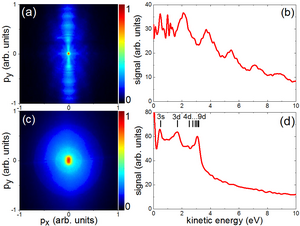As a result of the interaction of intense laser pulses with clusters, the measured electron spectra typically exhibit a continuous distribution. In the past, the absence of traces of discrete states led to the conclusion that the dynamics of charged particles during cluster expansion can be well described by a completely classical behavior. One effect of this is that simulations modeling the interaction of intense lasers with clusters, nanoparticles, or large molecules often rely on quasi-classical approaches. With the advent of new laser sources and time-resolved techniques within the last year, this image began to shake. Recently, efficient generation of excited atoms in nanoplasms has been reported, which is triggered by electron-ion recombination. When an atom with 2 electrons arises in excited states, it can decay by electron correlation, with one electron being emitted into the continuum, while the second electron relaxes to a lower bound state. However, since the electrons emitted in such an autoionization process exchange kinetic energy with the cluster environment, they have not previously been observed in experiments.
Classic or not? Physics of Nanoplasmas
Fig. 1 (a) Two-dimensional electron pulse image emitted by O2 molecules showing anisotropic distribution of the electrons with a maximum in parallel (vertical) direction to the NIR laser polarization direction. (b) In the corresponding kinetic energy spectrum, the observed peak structure is due to ionization above the threshold and Freeman resonances. (c) The electron-pulse pattern of O2 clusters with an average size of 2400 molecules exhibits a clearly isotropic behavior. (d) In the kinetic energy spectrum, 3 peaks appear, which can be assigned to autoionization processes as a consequence of the decay of super excited atomic states.
In a collaboration led by scientists from the Max Born Institute, the first evidence of autoionization as a result of the interaction between intense NIR laser pulses and clusters has now been reported. In the current issue of Physical Review Letters [114, 123002 (2015)], Bernd Schütte, Marc Vrakking and Arnaud Rouzée, as well as their colleagues Jan Lahl, Tim Oelze and Maria Krikunova from the TU Berlin present the results obtained in oxygen clusters , This system was chosen because it was already known that oxygen atoms have long-lived autoionizing states. In the current study, clear peaks were observed in the electron spectrum of oxygen clusters that were ionized with intense NIR pulses (Fig. 1). These peaks could be assigned to well-known autoionizing states and were shown to decay on a nanosecond timescale when the cluster has already expanded significantly. Therefore, the influence of the environment on the electrons emitted as a result of autoionization was negligible. The observed contributions of autoionization were very sensitive to the intensity of the NIR laser pulse. At greater intensities, the auto-ionization peaks were smeared, but were still visible. These results suggest that autoionization plays an important role in many experiments in which the interaction of intense laser pulses with particles on a nanometer scale is studied, even if these processes can not be directly observed in the electron spectrum. It has previously been shown that the observed nanoplasmic dynamics are similar as a result of intense XUV and NIR ionization of clusters, which is why it is expected that the current results also have high relevance for experiments on novel free-electron lasers. The experimental findings of autoionization are also important in order to improve theoretical models of nanoplasmas in the future and thus to gain a better understanding of the underlying microscopic processes.
Search publications of MBI
Publications since 2025
